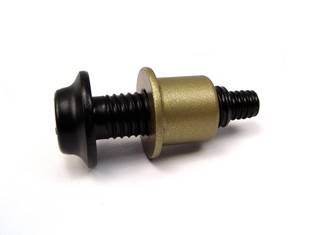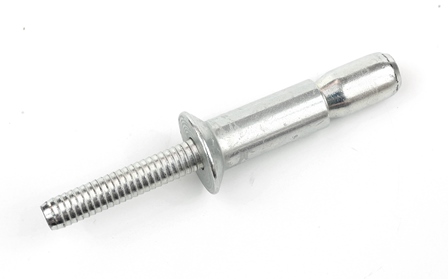
Alcoa Fastening Systems (AFS) is a leader in developing fastening technology and providing safety critical solutions for a variety of installations. Through its commitment to quality and innovation, it has established itself in key markets, including commercial transportation, automotive and rail. Now the company is looking to do the same in the structural and civil engineering market.
AFS has been involved in the civil engineering market for over 40 years. However, it is only recently that the company has looked to further develop the products and range it can supply to the market. A key achievement was the Deutsches Institut für Bautechnik (DIBt) approval for its structural fasteners, both Huck® BobTail® lockbolts (pictured right) – the advanced two-piece fastener – and also blind fasteners.
“In the structural market you are dealing with engineers who want absolute confidence in what they do,” explains Jonathan Craven, operations director, AFS industrial operations UK. “We are talking about large civil engineering structures that involve safety critical applications. This means, we have to operate within the DIBt standard to meet the needs of that market. Achieving the DIBt standard gives us the possibility to market authoritatively.”

A leading product in the AFS product range that received DIBt approval was the Huck BobTail – a lockbolt system that is entirely vibration resistant and has an extraordinary fatigue life – with the product achieving DIBt approval for static and dynamic structures. “That approval goes to the extent that it gives functional performance, but it also makes the statement that the installed joint is maintenance free,” proudly states Jonathan. “That creates an opportunity because one of the limiting factors and cost of conventional nuts and bolts is the ongoing need for regular inspection and retightening. By proving that the BobTail lockbolt is vibration resistant and maintenance free – in addition to offering high clamp retention and joint integrity for the life of the product – it makes the BobTail lockbolt an attractive proposition for companies.”
Compared with conventional lockbolt technology, the BobTail lockbolt design doesn’t involve a pin break. Normally the clamp to install a standard lockbolt is created by pre-tensioning of the pin; an anvil then slides over the collar to swage it and at that point, when it is engaged fully with the collar, the pressure rises and the pin snaps off. With the BobTail lockbolt, there is no pin break. The pin is simply pulled, the collar is installed, and then it retracts. This means that the customer is left with an intact pin and an intact collar. A key benefit of not having a pin break is that the assembly is even more corrosion resistant.
“Our coatings for the BobTail lockbolts are compliant to the DIBt and to ISO 12944 standards up to C5M high, which includes offshore external joints,” mentions Jonathan. “To reach the ISO 12944 standard requirements, it is necessary to test the fasteners for 1,440 hours (approximately two months) in a salt spray corrosion cabinet. In order for us to be confident that we could reach C5M high, we went to 2,160 hours in the salt spray corrosion cabinet. This meant the product had to be below the first signs of red rust, whilst installed for almost 3 months in a salt spray corrosion cabinet. This is quite a big test, but by completing these types of tests it gives the product extra credibility.”
The Butzkies Stahlbau GmbH lattice wind tower erected using Huck®BobTail® fasteners. From left to right: Alexander Petri, sales manager AFS, and Detlef Bengs, MD of Butzkies Stahlbau

From the way in which he talks, it is clear that Jonathan is passionate about the BobTail lockbolt and its unique features. “Overall I am biased because I know that it is a great technology,” says Jonathan with a wry smile. “What I would say is that it’s an evolutionary step forward from conventional lockbolts.
If you compare a BobTail lockbolt with an equivalent sized nut and bolt, the fatigue life of the BobTail lockbolt is approximately 5 times greater. If an engineer is working with a dynamic application, then obviously this is a critical benefit.”
From feedback AFS has received from the market, it is looking to further develop its service, by extending theBobTail lockbolt diameter range available with DIBt approval.
“We have spoken to some of the larger civil engineering companies in continental Europe and they are all interested in large diameter lockbolts,” explains Jonathan. “We are therefore going through a process of developing large diameter BobTail lockbolts. Once they are ready, they will go through an extension of the DIBt approval process, which will enable us to offer customers an expanded range of fully approved products.”

In addition to the BobTail, AFS also developed a DIBt standard for its Huck® Magna-Lok® structural blind fastener (pictured above) – a sleeve-expanding product that offers single sided joining and rapid installation. The Magna-Lok blind fastener has a wide grip range and the pin lock is inside the sleeve, so it can be used in large joints. Installation can be done on-site using portable power rigs or small hydraulic units, and requires minimum operator expertise.
The DIBt approval for the Magna-Lok blind fastener came up for renewal in 2012, and AFS took the opportunity to not only extend the range, but also the scope of the DIBt approval to include both static and dynamic structures.
“The original DIBt approval was for the Magna-Lok fastener and another product – Magna-Bulb® blind fastener – and was only for static structures. However, when we renewed the standard we decided to focus on the Magna-Lok fastener because it is a more popular product for steel construction,” says Jonathan. “By extending the scope of the approval it also gives us a unique level of accreditation because to my knowledge, we are the only manufacturer of 12.7mm DIBt blind fasteners approved for dynamic structures.”
Jonathan enthuses: “The Magna-Lok blind fastener is a fantastic, robust, versatile fastener. It has a great grip range, enormous strength and it is superb at closing gaps – making it ideally suited to joining a wide range of materials. It also offers speed of assembly and functional performance improvements, which make it the perfect product for racking housing, steel construction and modular building applications.”
Thanks to its DIBt approved products, AFS is attracting interest from across Europe, as well as North America. “Whilst the DIBt is essentially a German standard, it is internationally recognised. The performance benefits our products deliver – and the fact that there is a definition within the civil engineering approval that states that our BobTail fasteners are maintenance free – has generated a lot of market interest,” says Jonathan. “We are already seeing projects where counterparts in Europe and North America are working in parallel, but on separate projects, and require the same technology. Customers are becoming more aware of our capabilities and products, and then from there it evolves.”
Through the BobTail and Magna-Lok, AFS is able to provide customers with high-quality, approved products that have distinctive benefits, depending on the structural and civil engineering installations they are used. To ensure customers are aware of what each product can deliver, AFS works closely in partnership with the customer to find the ideal solution.
“It is very important that as a company we have a dialogue with our customers so that we can work with them on finding the right product for their application,” states Jonathan. “By working closely with these companies, we can propose the right fastening solutions for their design technologies. We are also happy to bring a product to market while partnering with a key customer. I believe that you cannot design and develop really successful fastening technology in isolation from the market. You can, however, go on that journey with a customer and both benefit at the end of it.”
Jonathan concludes: “At AFS we are in a continuous cycle of looking to increase functionality and add new performance criteria to our products, as well as increase product awareness. For us, it is about looking at the bigger picture. It is about establishing ourselves in a market where we are not historically well established. We have built the products, the range and the approvals, so the next stage is to continue to engage with customers and take our engineering to them, and wave the flag for our best in class fastener technology.”

Will joined Fastener + Fixing Magazine in 2007 and over the last 12 years has experienced every facet of the fastener sector – interviewing key figures within the industry and visiting leading companies and exhibitions around the globe. Will manages the content strategy across all platforms and is the guardian for the high editorial standards that the brand is renowned.





